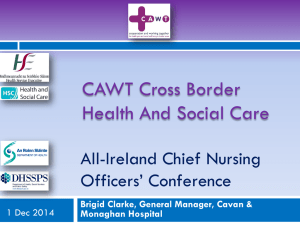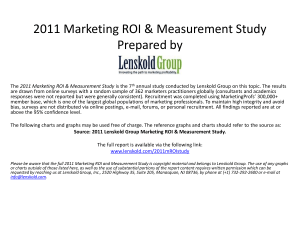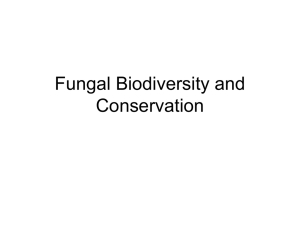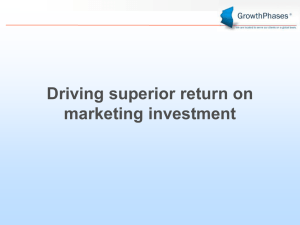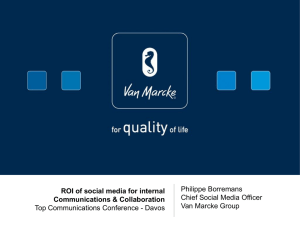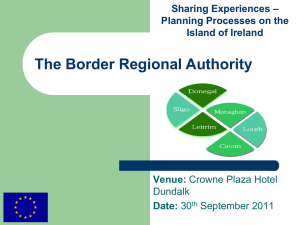all the Powerpoint presentations in one file
advertisement
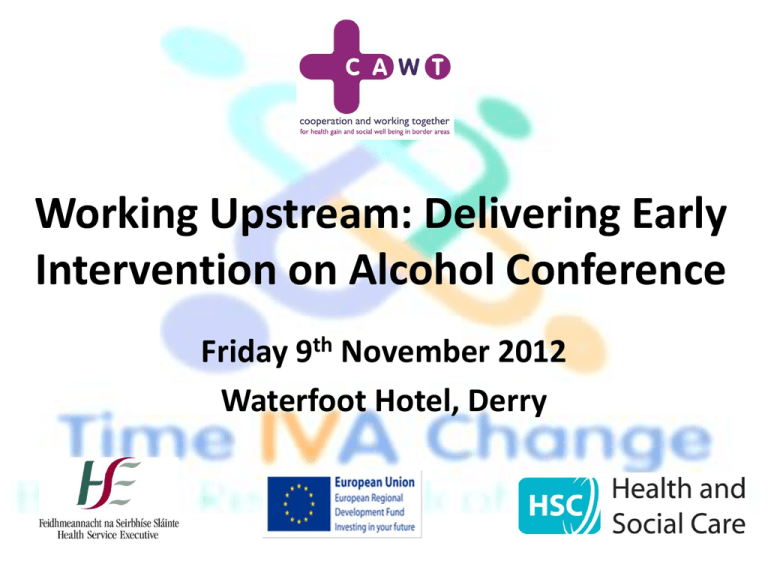
Working Upstream: Delivering Early Intervention on Alcohol Conference Friday 9th November 2012 Waterfoot Hotel, Derry Session 1: Joining up Early Intervention: Setting the Scene Chair: Bernie McCrory Chief Officer, CAWT Civic Welcome Alderman Mary Hamilton Deputy Mayor, Derry City Council CAWT – Moving Upstream: Testing Early Intervention approaches in the border region Edel O’Doherty Deputy Chief Officer CAWT Aim of Presentation • To provide a brief overview of the work of Cooperation and Working Together (CAWT) • To highlight CAWT’s approach to early intervention CAWT - What we do Facilitate the health services in the border region to work together and with other community/voluntary sector partners to tackle common challenges Attract EU funding to support the development of ‘additional’ services, based on local need Innovate – pioneer and test out new ways of delivering health services to improve health and social care on a cross border basis EU INTERREG IVA 12 cross border services /projects Acute Hospital Services Support for Older People Sexual Health Services / GUM clinics ‘UP4IT!’ - Preventing and Managing Obesity – Eating Disorder Services ‘Citizenship’ - for People with a Disability ‘Time IVA Change’ – Border Region Alcohol Project ‘Turning the Curve’ Autism Support Project Improving Outcomes for Children and Families Reducing Social Exclusion and Health Inequalities Improving the Management Diabetes in High Risk Clients Cross border Workforce Mobility Where we are delivering Project Disability / Citizenship Outcomes for Children Social Inclusion GUM services Obesity Acute Services ENT Acute Services Urology Acute Services Vascular Ophthalmology Oral Maxillo Facial Surgery Older People Autism Alcohol Mobility Diabetes Eating Disorders Colour Code Beneficiary targets 21,840 Target no. of Beneficiaries 25,153 Beneficiaries achieved 17,182 Beneficiaries achieved 2010 2011 (December) 2012 (July) 2014 Prevention and Early Intervention CAWT – Rationale for early intervention CAWT Border region 1.6 million people • Growing and Ageing Population • Increased prevalence of long term chronic conditions leading to high demand for hospital beds • High level of unemployment/poverty, deprivation/rural isolation • Strong correlation between poverty and social isolation and ill-health • High levels of Cancers, Circulatory and Respiratory Diseases, RTA’s and Suicides Moving upstream or simply plugging gaps Northern Ireland (Transforming your Care) • Fastest growing population in UK and continues to grow • Increase chronic conditions such as hypertension, diabetes, asthma • Sharp rise in suicides and self harm • 340,000 smoke • 2,400 avoidable smoking related deaths • 59% of all adults overweight or obesity • Alcohol and drug misuse costs on average £600 million to society • Estimated demand for services to grow by 4% by 2015 Republic of Ireland (Your Health is Your Wealth) • • • • • Chronic diseases such as diabetes, heart disease and many cancers forecasted to double over a 20 year period. Improvements in life expectancy gained threatened by rising rates of obesity. Greater health inequalities and life expectancy among poorer people. Ageing population presents considerable challenges. Every 7 hours someone dies from an alcohol related disease. Financial Climate Northern Ireland • To provide an efficient service, £5.4bn is needed by 2015 - instead allocation is 4.6bn – a shortfall of £800m. • The health budget is down by 2.4%. • Remodelling of how money is spent – shift of £83m from hospitals to primary, community and social care Republic of Ireland • HSE annual budget of €14 billion • Over the last two years, total budget reductions in the HSE of €1.75 billion have been implemented. • By the end of August 2012 the HSE was €259 million over budget • The total cost reduction target in 2012 €750 million. The case for change ‘The inevitable outcome without change to the status quo will be an unplanned and unmanaged collapse in key health and social care services’. Transforming Your Care – A review of Health and Social Care in Northern Ireland 2012 Why Early intervention? There is empirical evidence stacked from the floor to the sky that backs up our taking a different approach to preventive spending and investment in early years (Scottish Health Minister Tom McCabe) Health investment needs to become developmental not remedial (Graham Allen Review – Good Parents, Great Kids, Better Citizens) On a practical level early intervention pays a very high rate of return. The dividend is 12-16% per year for every £1 of investment (Transforming your Care) CAWT Moving upstream - Early Intervention in practice • • • • • • • Outcomes for Children Diabetes Social Inclusion Obesity Eating Disorders Turning the Curve Time 4 A Change – Alcohol Outcomes for Children • Improving Outcomes for Children through an interagency approach › Locality Planning Groups established across border region. › 5 Programmes – 700 beneficiaries › 52 staff trained in using outcomes based planning tool Diabetes – Structured Patient Education High Risk Groups • Specialist pre-pregnancy care clinics for women with diabetes planning pregnancy • Education for children and young people with diabetes • Diabetes Nurse specialists and Dieticians recruited to deliver CHOICE Education Programme • 1,549 beneficiaries Social Inclusion/Health Inequalities Working in partnership with the C&V sector to tackle health inequalities • 3 strands to project (Vulnerable Women/Travellers and Improving Access) –Mental Ill-health –Domestic violence/esteem building –Mothers with disabled children –New mothers –Older Women 2300 beneficiaries Prevention and Management of childhood obesity Obesity: A community focused approach to managing and preventing obesity among children 4 pilot sites within border region • Evidenced based, family centred approach to healthy eating, exercise and positive mental health. • 1800 beneficiaries (466 families) Eating Disorders Project • Enhancing therapeutic eating disorders services at Tiers 1 and 2 • 12 Eating Disorder Therapists in place working within CAMHS • Carer support groups established • 1200 GP’s and PC staff trained in early recognition and intervention • Service leads in Trust already experiencing a reduction in Tier 3 as a result of project • 434 beneficiaries received 1-1 services Autism ‘Turning the Curve’ • Improving the lives of children and young people with autism and their families/carers through ‘transition’ support • young people receiving Transition support/ 125 family members • Summer respite – 143 young people/502 family members Alcohol – Time IVA Change • Multi-level harm reduction – Early Intervention (maternity services/primary care) – 750 pregnant women availed of alcohol screening. – An additional 1866 clinical early interventions (as at Sept 2012) – 241 families supported – Roll out of Strengthening Families Programme – Community Mobilisation – supported 8 communities to challenge negative alcohol culture. Alcohol working upstream 1 Point 2 Next steps • Evaluating project outcomes– demonstrating what works/lessons learned • Influencing mainstreaming of services or ‘re-engineering’ of existing resources. • Managing project closures where appropriate • Planning for next round of EU funding ie INTERREG 5 • Continue to lobby for investment in Early Intervention approaches. • Demonstrate the economic, social and personal impacts of EU investment. www.cawt.com Alcohol in Ireland a North/South Comparison Eamon O’Kane Director, Derry Healthy Cities A Tale of Two Countries Northern Ireland Republic of Ireland - Population • 2011 - 1,810,900 people • 30% of the island's total population - Population • 2011 - 4,581,269 people • Ranked the 7th most developed country in the world by the United Nations Adult alcohol consumption Social harm in Europe 14 Fight % reporting problem (of all population aged 18-64) Source: ECAS 12 Work/studies 10 Homelife/marriage 8 6 4 2 0 Ireland Finland Sweden Germany UK France Italy Economy NI • Licensed Trade worth c.£1 Billion per year • c.34,000 jobs directly & indirectly • 1/3 of tourism spend on food and drink (c.£ 1/2 Billion per annum) • DHSSPS estimate pubs pay c.£2 Million annually into Arts, Sports & Charities • c.25% of alcohol is purchased in pubs ROI • Market worth over €6 billion per year • Approximately €2 Billion in Excise and VAT • 50,000 jobs directly and indirectly • Major export product with internationally recognised branding • Key feature of Tourism product (€3.5 Billion) • <50% purchased in pubs Health/Social Care NI • Annual Cost - £250 Million • 5 deaths per week • 2010/11, over 12,000 acute admissions • 1 March 2010 - >3,000 in treatment for alcohol misuse ROI • Annual Cost - €1.2 Billion • 3 deaths per day • 2000 acute beds per night • Acute admissions doubled 1995 to 2008 • 7,940 admissions to specialised treatment in 2008 Suicide & Self Harm NI • A contributing factor in at least 50% of all suicides • A major contributing factor in 63.8% of all episodes of self-harm ROI • A contributory factor in ½ of all suicides • Consumed in 4 out of 10 episodes of selfharm Driving NI • Legal limit for driving – 80 milligram's of alcohol in 100 millilitres of blood for all drivers – Legislative change imminent in NI ROI • Legal limit for driving – 50 milligram's of alcohol per 100 millilitres of blood for experienced drivers – 20 milligram's of alcohol per 100 millilitres of blood for other drivers • Estonia, Romania, Slovakia, Hungary, Czech Republic = zero tolerance • Sweden, Norway, Poland = 20mg • UK ,Luxembourg = 80mg • All other European States – 50mg Road Deaths NI ROI • Average 25 people killed & 119 seriously injured every • Alcohol a contributory factor in 1 in 3 fatal collisions. • 2003 to 2007 – 127 people died in collisions (20% of all road deaths in Northern Ireland in that period.) – 595 people were seriously injured – 10% of all serious injuries NI roads • Most common factor in all fatal collisions between 2001 & 2004 in the Republic’s border counties • 1990 to 2006 - 2,462 road fatalities were alcohol related Drinks Measures NI – Units • 1 Unit = 8 grams of pure alcohol – Alcopop = 1.5 units – 35ml of spirits = 1.5units • Men – no more than 3 to 4 units per day or 21 units per week • Women – no more than 2 to 3 units per day or 14 units per week. • Binge drinking – Man 10 or more units in one session – Woman 7 or more units in one session ROI - Standard Drink • 1 standard drink = 10 grams of pure alcohol – Alcopop – 35.5 ml of spirits • Men – less than 17 standard drinks per week with at least two alcohol free days • Women – less than 11 standard drinks per week with at least two alcohol free days • Binge – 6 more standard drinks Consumption NI • 7 out of 10 adults drink alcohol (Males 79%, Females 70%) • 4 in 5 adults exceed recommended daily limits (Males-79%,Females-83%) • ¼ exceeds weekly sensible levels • Younger adults (18-29 years) more likely to exceed weekly guidelines ROI • 89% males, 85% females current drinkers • 31% of men , 21% of women consume alcohol at least twice weekly • 27% consume 7+ standard drinks/drinking occasion • 20% experienced at least one of six harms as a result of their drinking Price & Availability NI • 62% more affordable today than almost 30 years ago • Between 2005 & 2009 – 118 pubs closed – Value of off-trade sales increased by 1/3 • Within UK, lowest expenditure on alcohol but highest on drinks consumed outside the house ROI • 50% more affordable between 1996 & 2008 • 1998 to 2008 – 161% increase in the number of off-licences – Pub-licences decreased by 29% • Pub Prices increased 300% in 10 years - in off-sales price fell 50% in same timeframe. • Spending 3 times more than European households Pubs with Alcohol Licences 2005 2006 2007 2008 2009 NI ROI 1,568 1,488 1,475 1463 1,450 8,922 8,894 8,842 8,086 7,980 Children Drinking NI • Over half of pupils report ever having drunk alcohol • 55% of whom report being drunk on at least one occasion. • Girls more likely to report being drunk than boys ROI • Over half of 16 year olds have ever been drunk • 1 in 5 is a weekly drinker • Average age of first consumption decreased from 16 years for those born in 1980 to 14 years for those born in 1990 Hidden Harms NI ROI • At least 4,000 children living with someone with an alcohol problem • 271,000 children (children u15 yrs) or up to 587,000 children (all ages) exposed to risk from parental hazardous drinking WHO estimate adult alcohol problems are associated with 16% of child abuse cases OPPORTUNITIES & SYNERGIES • • • • • • • • National Substance Misuse Strategy (ROI) – 2009 to 2016 New Strategic Direction for Alcohol & Drugs( NI) – 2011 to 2016 Fit & Well NI – 2012 Your Health is Your Wealth ROI – 2012 Alignment of Drink Driving Legislation North South Ministerial Agreement on Alcohol (January 2012) INTERREG V MINIMUM PRICING Without Increased Action In 10 Years • 13,000 + people will die from an alcohol condition on this Island • Over 1 Million cases will pass through justice system • Age of first drinking will continue to fall • Collective Costs – Economy - £38 Billion – Health Services c. £ 15Billion + Management is doing things right, Leadership is doing the right things. Crossing Boundaries with Early Intervention- the CAWT Time IVA Change Border Region Alcohol Project Caitriona Mullan, CAWT Project Manager A Working Vision A cross-border initiative which uses partnership and finite resources to develop workable, robust and affordable models for awareness raising, community ownership, and early intervention to reduce alcohol harm; and which provides one response out of many required to alleviate the suffering and damage that misuse of alcohol causes the population, in particular the children and young people, of the Ireland/Northern Ireland Border Region Partners • CAWT partners: WHSCT, SHSCT, HSE Dublin North East, HSE West, NI Public Health Agency, NI Health & Social Care Board, DHSSPSNI, DOHC • Project partners- all of the above plus 2 NGOsDerry Healthy Cities and the Alcohol Forum (Donegal). Project Delivery • Demonstrate workable best practice in clinical, community and family support settings- all aimed at working upstream; 1. Early intervention Service: Clinical Health Service partners: Client-facing referral + systemic practitioner training and support 2. SFP Pilot for NI: WHSCT, PHA and Derry Healthy Cities 3. Community Mobilisation (Derry Healthy Cities, Alcohol Forum- Pilot in Donegal, Derry/Tyrone) The Bottom Line: • 1,886 clinical beneficiaries (Early Intervention Service) as at 30th September (original overall target 1,800) • 621 health & social care practitioners trained (Applied Early Intervention Techniques, BI into core practice, SFP) • 241 families supported through Early Intervention Service family-orientated approach (includes SFP) • 5,484 community participants Community Mobilisation pilot activities Project Philosophy and Culture- The Story Behind the Figures • Legacy: networks, skills, practice shift, impact on service users and their families • Practice-led advocacy for change (present solutions that work) • Cross-disciplinary leadership for change – what do we mean? • Networks of knowledge and commitment • Effect: Skilling the system- Alcohol everyone’s business • Recovery Philosophy in Early Intervention context Tools for Change- Project Products • • • • • • • • Hidden Harm Prevention in Action: Partnership between Addictions and Maternity Services (NI); Partnership with Family Support Services (across the region); family-oriented support for Early Intervention clients Perinatal Service Standard: CYPSF- Supporting mothers with complex needs Prototype Maternity Services Screening and Referral toolkit- Developed by WHSCT Early Intervention Service (Workshop 1, Marie Dunne) Alcohol & Pregnancy Leaflet- available to all CAWT Partners in PDF pending production Content for new edition NI Pregnancy Handbook – in partnership with PHA Midwife Consultant 750 pregnant women in WHSCT area of NI risk screened for alcohol misuse in pregnancy Partnership Model for Working with Community Campaigns on Alcohol & Pregnancy (Joanne Smith, Drink Think Project, Workshop 4) Subregional Evidence base of risk of hazardous maternal drinking in pregnancy Tools For Change- Project Products • • • • • • • WHSCT: Family Support Hub staff trained in Alcohol Brief Intervention Approaches- Interdisciplinary team work for families at Tier 2 (Workshop 2, Mark McChrystal) SHSCT: Integrated Early Intervention Network Multidisciplinary co-operation across addictions, CAMHs, Maternity (Workshop 1, Kevin Morton) HSE Dublin North East: Targeted referral pathways and client support for socially excluded groups- Mental Health/Social Inclusion/National Reform Programme (EU); Direct Referrals from Probation Services and Family Intervention Teams HSE Sligo Leitrim: Partnership with Sligo IT Student Counselling Service- direct referrals; Partnership with GAA HSE Donegal: Built capacity of Addiction Services to support clients as parents and family members Community Skills: Community Mobilisation Toolkit, Responsible Server Training, Streetwise 4 Life Schools Programme, Support to Derry Civic Alcohol Forum (Karen Phillips, Anne Timoney, Workshop 3) Portrait of an early intervention service- Cross-Border regional service profile data, intervention packages, demographics. Change in a Changing Environment • Project staff have been the key to success- champions of change in a changing environment • Partnership with Service Users • Wider networks of project ‘allies’- people willing to champion change in their own setting, understand the role of alcohol and draw on practice supports we have offered: eg: social workers, practice nurses, GPs, family support workers, speech & language therapists, Midwives, Health Visitors. • Crossing boundaries- jurisdictional, organisational, disciplinary, cultural (social and institutional) Working Upstream: Comments • We have the evidence of need • We need to listen to service users and understand the journey • Time IVA Change has been Leading by Example • Leadership at all levels- recognition and value of all • Empathy and empowerment – guiding principles for service planning • We need to turn our face to the future, change how we deliver and change how we work together Getting There It can be done! Collaboration Instead of Competition Scrap the Silo, Don’t Redecorate It! Moving Upstream Paul Cavanagh Health and Social Care Board … Not a Health Issue • • • • • How society views alcohol How the public sector locates alcohol Alcohol bonding communities Alcohol bonding and breaking families Impact of alcohol on health and social care services • Community mobilisation and strengthening families Impact of Alcohol on HSC in NI • Estimated at some £250million in direct costs • Additional social costs estimated at almost £900million • Estimated that alcohol is a significant factor in 40% of all hospital admissions • Rising to 70% of Emergency attendances at weekends Impact of Alcohol on HSC in NI • Ambulance and other emergency services • Emergency Department, ICU and In-Patient Beds • Crash Beds, Detox and Addiction Treatment Services • Family Support and Intervention • Alcohol-Related Brain Injury Impact of Alcohol on Children • Foetal Alcohol Syndrome • Impaired parenting may lead to early behavioural and emotional problems in children • Higher risk of emotional and physical neglect or abuse • Lack of adequate supervision Impact of Alcohol on Children • Repeated separation from parents • Children taking on inappropriate caring responsibilities for siblings and parents • Social isolation • Disruption to schooling and school life • Early exposure to alcohol • Poor physical and mental health in adulthood Impact of Alcohol on Communities • • • • Family breakdown Anti-social behaviour Debt Dependence • Celebration and Enjoyment • Bonding Communities Society’s view of Alcohol • Positive – ‘Can’t have a celebration without it!’ • Ambivalent and conflicted – ‘The economic argument’ • Compartmentalised – ‘A Health Issue’ • Stigmatising – ‘The hapless alcoholic’ The Journey… • • • • • • • • A Paradigm Shift Focus on Emergency Response Focus on Addiction Focus on Families and Children Focus on Communities Focus on Partnership Focus on Strategy Focus on Behaviour The Journey so far… • Civic responsibility and partnership • Funding early intervention and community mobilisation • Community initiatives • Alternatives to emergency admissions • Home detox and treatment • Family support • Pricing Once in a Generation Working Upstream Conference Friday 9th November 2012 Gordon Jeyes CEO Designate Child & Family Support Agency Always Children First Moral Statutory Effective 68 Always Children First Agency Vision Outward looking, inclusive, evidence based, accountable Supportive when appropriate, assertive when necessary An Agency staffed by professionals: Clear in our values such as wisdom, integrity, compassion, justice, respect and courage Mindful of our limitations and our need to work as servants of responsible individuals, engaged communities, inclusive schools, responsive health services. We cannot do it alone but together there can be very significant improvement. 69 Always Children First Delivery requires.. 70 The support and permission of the community Management which offers high support to enable high challenge within clear lines of accountability. Strategy and policy developed on a nationwide basis with decisions and practice taken forward at the most practical local level Always Children First All services based on Agreed values Consistent approach by all service providers Open and transparent delivery Clear lines of professional accountability Evidence based interventions Joined up services Above all child and family centred. 71 Always Children First Interventions relating to impact of alcohol on families 72 Early intervention including, among others, quality early years provision, well resourced and inclusive schools, responsive health services. Cross cutting policies to address the root causes of problems which lead to the pernicious impact of poverty, neglect, drugs and alcohol on families. Government attention to the impact of alcohol on all aspects of society. Need for specific and effective provision of services which support children in areas such as mental health and addiction services. (Gordon Jeyes : on Child Deaths Review 2012) Always Children First A Shared Commitment “The support and protection of children cannot be achieved by a single agency… Every service has to play its part. All involved must have placed upon them the clear expectation that their primary responsibility is to the child and his or her family.” - Herbert Laming 73 Always Children First Universal Services E.g. Local Government, Education, Health Early Intervention / Prevention Target Services Available Local Community Services Point of Entry Screening Contact Concern Intake 74 Local Area Pathway Supporting Children and Families Formal Communication Mechanism Community & Voluntary Services (38 & 39) Referral Social Work Initial Assessment Child Welfare re cases at risk of formal intervention (DRM type response) Child Protection (CPNS) Other Community & Voluntary Services Always Children First Not open to social work Close Open to social work Child in Care A key priority To promote effective multidisciplinary shared practice and efficient community engagement 75 Always Children First Local Area Pathway To create a collaborative network of community, voluntary and statutory providers to improve access for children and families to support services at all levels of need. In the first instance early intervention should come from immediate family and community supported by professional services where appropriate and proportional. 76 Always Children First LAP co – ordinated services To operate a case coordination process for families with needs requiring multi-agency intervention but who do not meet the threshold for referral to the Social Work Department under Children First. Services should be family led, moving along a continuum of intervention to management by professional services only when this is deemed necessary in the best interests of childrens’ safety and in support of families 77 Always Children First Differential Response Model 78 Notification of concern brought to Child Protection System RED team Strengths based Family Assessment Services identified and sourced. Always Children First Going forward It is important that we continue to build on our shared evidence base deliver targeted services with a clear focus reflect on ways of minimum intervention build on family strengths avoid the creation of a culture of dependency. 79 Always Children First Aspirations If we have learned anything in recent years about improving services it is about the need for concerted community action, a full range of interventions from all disciplines and a recognition of the strengths and contribution of children and families. 80 Always Children First The Mysteries 81 Always Children First Session 2: What’s Working? Parallel Workshops Session 3: Delivering the change Next Steps: North- South Plenary/Panel Discussion Topics: 1. How do we move forward with Early Intervention on Alcohol? 2. What action is needed to shift towards early intervention in both health and social care systems/ at community/ civic level and who else needs to be involved? CLOSE Thank You
